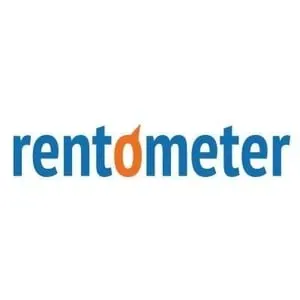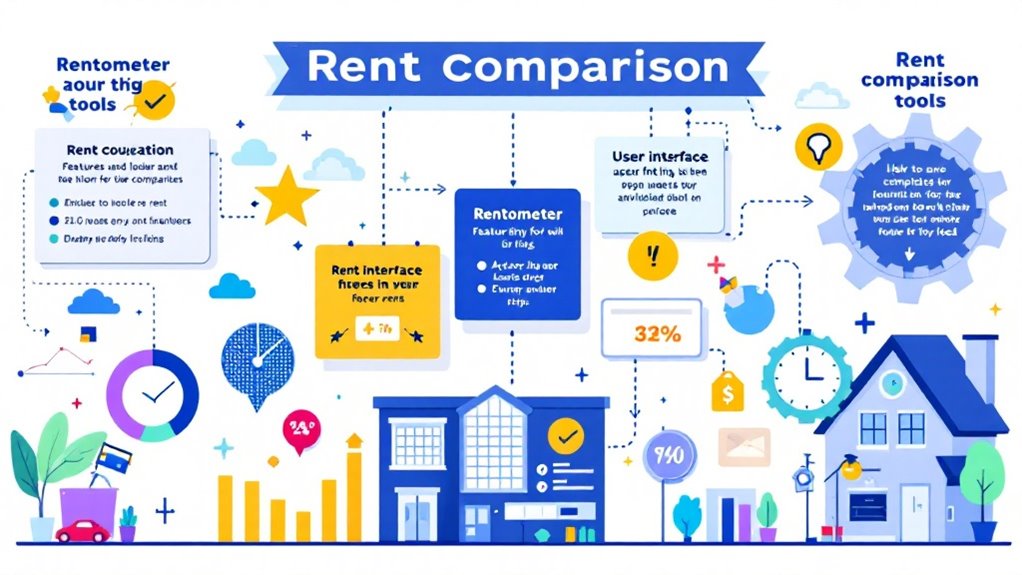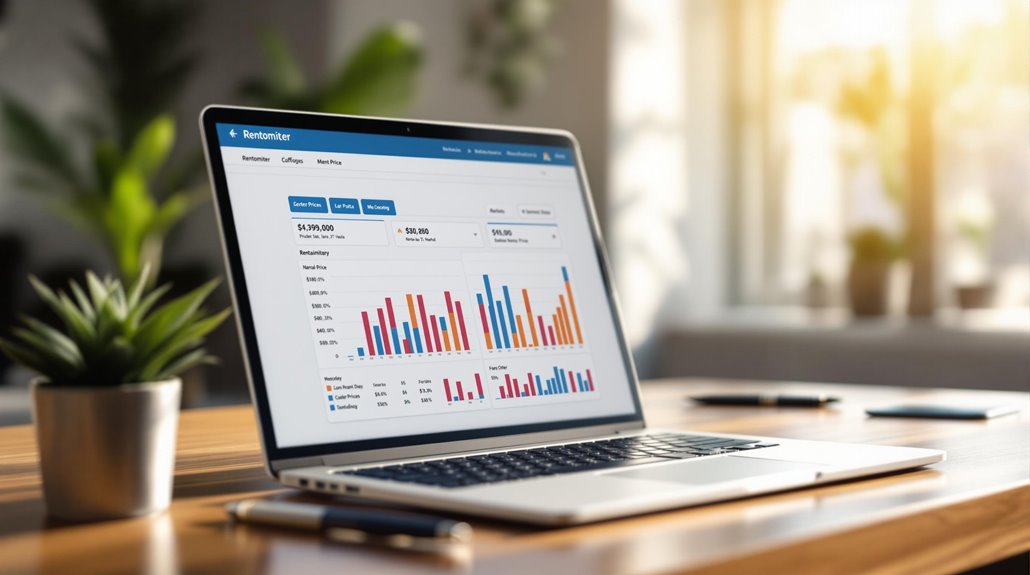You’re likely curious about Rentometer, a tool offering data-driven rental price analysis. It compares your property’s rent with local listings, providing insights into market trends. Daily updated data guarantees accuracy, helping you set competitive rates. Subscription plans start at $69 monthly, with a free trial available. The platform’s batch analysis, historical trends, and neighborhood reports are valuable for real estate investors seeking market insights. While Zillow and Trulia offer free alternatives, Rentometer’s analytical depth gives it an edge. Exploring further reveals how Rentometer’s tools can optimize your rental strategy and boost property management success.
Key Takeaways
- Rentometer provides detailed rent analysis reports, comparing property rent against local listings for accurate pricing strategies.
- Batch Analysis Tool allows simultaneous analysis of up to 100 properties, enhancing efficiency for property managers and investors.
- Historical Rent Trends and Neighborhood Reports offer insights into market growth and granular local data, respectively.
- Subscription plans include flexible options, such as a monthly plan, annual plan, and Pro Membership, catering to different user needs.
- Rentometer’s data source is regularly updated with public listings, ensuring current and accurate rental market insights.
Understanding Rentometer’s Features
When you’re evaluating rental properties, having accurate data is vital, and Rentometer’s features guarantee you have the insights needed for informed decisions. By leveraging the Rent Analysis Report, you can compare your property’s rent against similar rental listings in the area. This tool provides a thorough view of local rental prices, helping landlords and property managers set competitive rates that attract tenants while maximizing revenue.
Rentometer’s Batch Analysis Tool is particularly beneficial when managing multiple properties. This feature allows you to analyze up to 100 properties simultaneously, generating detailed reports that streamline property analysis. With this capability, you can efficiently assess rental statistics across your portfolio, saving time and enhancing decision-making processes.
Understanding market dynamics is important, and Rentometer’s Historical Rent Trends feature offers valuable insights into market growth or stagnation. This data-driven approach enables strategic pricing decisions, making certain your rents align with market conditions and future projections.
For those new to Rentometer, the Free PRO Trial offers a risk-free opportunity to explore its capabilities. You can access up to five limited rental reports without needing a credit card, providing a cost-effective introduction to the platform’s offerings.
Moreover, customizable reports allow you to include your company branding, enhancing the professionalism of your rental pricing presentations. This feature is particularly advantageous for landlords and property managers looking to impress clients with tailored, branded insights.
Incorporating these analytical tools into your property management strategy guarantees you stay competitive and informed, making Rentometer an invaluable resource for understanding and maneuvering the rental market. Tracking KPIs is essential for assessing rental property performance, as it provides insights into crucial aspects like occupancy rates and cash flow patterns.
Evaluating Rental Price Accuracy
Evaluating rental price accuracy with Rentometer requires a vital approach, as the tool relies heavily on public listings for its estimates. While it’s a valuable resource for understanding general rent prices, it’s essential to recognize its limitations. The rental analysis provided often excludes important factors like property condition and amenities, which can greatly affect the rental price of a specific property.
Rentometer’s data is refreshed daily, reflecting recent market activity. However, discrepancies may arise when comparing estimated rents to actual rents paid in the local market. This is primarily because public listings, which form the backbone of Rentometer’s rental data, might not always capture the nuanced realities of a rental market. As a property owner or prospective tenant, leveraging Rentometer Pro can offer more detailed property insights and rental trends, but it still might not cover unique or less common rental situations thoroughly.
Understanding the local market dynamics enhances the reliability of rental price assessments by offering insights into unique trends and property values that tools like Rentometer might overlook.
| Aspect | Impact on Rentometer Accuracy |
|---|---|
| Data Source | Heavy reliance on public listings |
| Property Condition | Often excluded from analysis |
| Market Activity Refresh | Daily data reset |
| Unique Situations | Limited coverage in detailed reports |
For property owners, understanding these limitations is key to making informed decisions. Rentometer serves as a useful starting point for rental analysis, but it shouldn’t be the sole determinant of rental price decisions. By comparing Rentometer’s estimates with other rental data sources and considering specific property characteristics, you can achieve a more accurate understanding of the local rental market. Ultimately, while Rentometer provides valuable insights, its estimates may vary in reliability, urging the need for a thorough approach to rental analysis.
Subscription Plans Overview
 If you’re considering Rentometer’s subscription plans, understanding the cost and features of each option is essential for maximizing value. Rentometer provides a variety of subscription levels designed to cater to different user needs, whether you’re a casual landlord or a seasoned real estate professional.
If you’re considering Rentometer’s subscription plans, understanding the cost and features of each option is essential for maximizing value. Rentometer provides a variety of subscription levels designed to cater to different user needs, whether you’re a casual landlord or a seasoned real estate professional.
Starting with flexibility, the monthly subscription is priced at $69, offering a no-commitment approach for those who require short-term access to Rentometer’s tools. Alternatively, the annual plan, at $32.50 per month, offers a more cost-effective option for long-term users, providing consistent access to crucial features like property analysis and landlord management tools.
Before committing, you can take advantage of a 7-day free trial, allowing you to explore the platform’s capabilities, such as rental reports and batch analysis. This trial is instrumental in evaluating whether Rentometer aligns with your needs in examining rental properties effectively.
For those seeking extensive access, the Pro membership at $99 annually opens up unlimited reports and advanced features, including neighborhood searches and batch analysis, making it ideal for users who frequently engage in property analysis.
The Pro Flex Plan offers a unique alternative, allowing you to purchase 20 rental reports for $29, with the flexibility to use them over a year. This plan is perfect for users who need sporadic access to Rentometer’s services without committing to a monthly or annual subscription.
Each subscription level is thoughtfully designed to provide varying degrees of access and features, ensuring you can find a plan that aligns with your specific rental property analysis needs. Utilizing tools like these can enhance your understanding of rental property dynamics and improve your investment strategies.
Tools for Real Estate Investors
Rentometer offers a suite of powerful tools tailored for real estate investors, enhancing your ability to make data-driven decisions. At the forefront, the Market Finder tool is indispensable, providing key metrics for rental markets across the U.S. This tool empowers you to pinpoint profitable areas for your investment property ventures. With Rentometer Pro, you gain access to over nine property analysis calculators, streamlining rental analysis and helping you evaluate potential returns with precision.
One standout feature is the Deal Finder tool. It boasts customizable filters and notifications, allowing you to spot potential investment opportunities efficiently. Whether you’re a novice or seasoned investor, this tool guarantees you don’t miss out on lucrative deals. Additionally, the batch analysis feature lets you assess multiple properties simultaneously, generating thorough reports that include mean, median, and max rents. Google Analytics is a valuable tool for closely tracking website performance and understanding visitor behavior, making it essential for improving rental property marketing strategies.
| Tool | Benefit |
|---|---|
| Market Finder | Identifies profitable rental markets in the U.S. |
| Deal Finder | Customizable notifications for new investment opportunities |
| Property Analysis | Over 9 calculators for in-depth rental property evaluation |
| Batch Analysis | Simultaneous assessment of multiple properties |
Rentometer’s property management software further enhances efficiency, making it seamless to manage rental properties and tenant relations. This software is an asset for increasing your rental income by streamlining operations. For more in-depth insights, the Neighborhood Report provides granular rent data specific to your area, equipping you with the knowledge to make informed decisions.
Whether you’re leveraging Rentometer Pro or utilizing its free tools, Rentometer arms you with the essential data and analytics to maximize your investment property’s potential.
Comparing Alternatives to Rentometer

Why consider alternatives to Rentometer? If you’re diving into real estate investing, exploring other options can enhance your rental pricing strategy. Alternatives like Zillow and Trulia provide broader data sources, pulling information from an extensive pool of public listings. This can be vital for obtaining a more thorough view of rental pricing in your target area.
- Zillow and Trulia: These platforms offer free online rental comparisons and pull from a wide array of listings, which might provide a more robust rental pricing analysis tool than Rentometer’s proprietary data.
- Mashvisor: Known for its investment property analysis, Mashvisor provides unique features like Airbnb rental data and a color-coded Heatmap, which can visualize market metrics effectively, offering insights beyond Rentometer’s capabilities.
- Craigslist: While it gives you direct access to rental listings, it lacks the analytical depth you might need for real estate investing. Its absence of Rent Analysis reports and Pro offers makes it less detailed.
- RentFax and RentRange: These paid services deliver detailed market stability reports, enhancing your analysis with more depth than Rentometer’s free offerings. They’re reasonably priced given the extensive insights they provide.
- Local Real Estate Agents: They offer tailored market insights and personal expertise specific to your area, which can be more nuanced compared to Rentometer’s generalized data.
Choosing the right analysis tool depends on your needs. If you require detailed, localized insights, or data-rich reports from public listings, the right alternative could make a significant difference in your property investments. Properly understanding tenant preferences through these tools can lead to better occupancy rates and higher rental income.
Conclusion
In the vast sea of rental analysis tools, Rentometer stands out like a lighthouse guiding investors to informed decisions. You’ve explored its features, evaluated its price accuracy, and considered its subscription plans. With tools tailored for real estate investors, Rentometer equips you with data-driven insights to stay competitive. While alternatives exist, Rentometer’s all-encompassing package remains compelling. Immerse yourself in the numbers, trust the process, and let Rentometer illuminate your path to successful investing.




